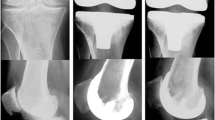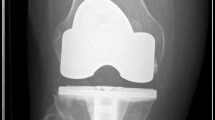Abstract
To present representative data of long-term survivorship and clinical outcome for the PFC total knee arthroplasty (PFC-TKA). A consecutive series of 141 TKA was followed for a mean of 13 years (range, 11–16 years). Sixty-five knees were evaluated, 30 of these clinically and radiographically. Twenty-eight knees could only be assessed with the use of a questionnaire. Six patients were living in nursing homes. Fifty-four patients (65 knees) had died. Eleven had undergone a revision. One patient was considered lost to follow-up. With re-operation for any reason as the endpoint, the 10-year survival rate was 92% (n = 91 patients at risk), and the 14-year survival rate was 91% (n = 12). With aseptic loosening of the implant as the endpoint, the 10- and 14-year survival rates were 97%. The mean Knee Society and function scores were 76 and 48 points, respectively. In this multi-surgeon series modular fixed-bearing TKA had good clinical and radiographic results with excellent long-term survivorship.
Résumé
Le but de cette étude est de présenter des données concernant la survie à long terme et le devenir clinique des prothèses totales de genou de type PFC. Une série consécutive de 141 prothèses ont été suivies en moyenne 13 ans (de 11 à 16 ans). 65 genoux ont été évalués, 30 sur le plan clinique et radiographique, 28 uniquement à l’aide d’une questionnaire. 6 patients vivent en institution et ne peuvent se déplacer et 54 patients (65 genoux) sont décédés. 11 patients ont nécessité une réintervention. Un seul patient est considéré comme perdu de vue. si l’on considère que la réintervention est le critère analysé dans la courbe de survie à 10 ans, celle-ci est de 92% (n = 91 patients) et à 14 ans le taux de suivi est de 91% (n = 12). Si l’on considère maintenant comme critère de la courbe de survie le descellement aseptique à 10 et 14 ans, la courbe de survie est à 97%. Le score de la Knee Society et le score fonctionnel sont respectivement à 76 et 48 points. En conclusion, cette étude multi-opérateurs d’une prothèse totale du genou modulaire mais à plateau fixe a montré une bonne évolution clinique et radiologique avec une survie à long terme.


Similar content being viewed by others
References
Archibeck MJ, White RE Jr (2006) What’s new in adult reconstructive knee surgery. J Bone Joint Surg Am 88(7):1677–1686
Buechel FF Sr (2002) Long-term followup after mobile-bearing total knee replacement. Clin Orthop Relat Res 404:40–50
Dawson J, Fitzpatrick R, Murray D, Carr A (1998) Questionnaire on the perceptions of patients about total knee replacement. J Bone Joint Surg Br 80(1):63–69
Dawson J, Fitzpatrick R, Murray D, Carr A (2006) A response to issues raised in a recent paper concerning the Oxford knee score. Knee 13(1):66–68
Devane PA, Horne JG, Martin K, Coldham G, Krause B (1997) Three-dimensional polyethylene wear of a press-fit titanium prosthesis. Factors influencing generation of polyethylene debris. J Arthroplasty 12(3):256–266
Dixon MC, Brown RR, Parsch D, Scott RD (2005) Modular fixed-bearing total knee arthroplasty with retention of the posterior cruciate ligament. A study of patients followed for a minimum of fifteen years. J Bone Joint Surg Am 87(3):598–603
Insall JN, Dorr LD, Scott RD, Scott WN (1989) Rationale of the Knee Society clinical rating system. Clin Orthop Relat Res 248:13–14
Meding JB, Keating EM (2001) Overview: long-term followup: predicting the success of a total knee arthroplasty. Clin Orthop Relat Res 388:7–9
Ranawat CS, Flynn WF Jr, Saddler S, Hansraj KK, Maynard MJ (1993) Long-term results of the total condylar knee arthroplasty. A 15-year survivorship study. Clin Orthop Relat Res 286:94–102
Rand JA, Trousdale RT, Ilstrup DM, Harmsen WS (2003) Factors affecting the durability of primary total knee prostheses. J Bone Joint Surg Am 85-A(2):259–265
Ritter MA, Berend ME, Meding JB, Keating EM, Faris PM, Crites BM (2001) Long-term followup of anatomic graduated components posterior cruciate-retaining total knee replacement. Clin Orthop Relat Res 388:51–57
Schai PA, Thornhill TS, Scott RD (1998) Total knee arthroplasty with the PFC system. Results at a minimum of ten years and survivorship analysis. J Bone Joint Surg [Br] 80(5):850–858
Tarkin IS, Bridgeman JT, Jardon OM, Garvin KL (2005) Successful biologic fixation with mobile-bearing total knee arthroplasty. J Arthroplasty 20(4):481–486
Vessely MB, Whaley AL, Harmsen WS, Schleck CD, Berry DJ (2006) The Chitranjan Ranawat Award: long-term survivorship and failure modes of 1000 cemented condylar total knee arthroplasties. Clin Orthop Relat Res 452:28–34
Author information
Authors and Affiliations
Corresponding author
Additional information
Approval of the ethics committee of the University of Heidelberg was given for this study on May 27, 2004 under the registration no. 097/ 2004.
Rights and permissions
About this article
Cite this article
Parsch, D., Krüger, M., Moser, M.T. et al. Follow-up of 11–16 years after modular fixed-bearing TKA. International Orthopaedics (SICOT) 33, 431–435 (2009). https://doi.org/10.1007/s00264-008-0543-x
Received:
Revised:
Accepted:
Published:
Issue Date:
DOI: https://doi.org/10.1007/s00264-008-0543-x




